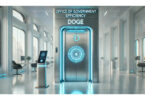Highlights
- Launched GoDirect Trade aircraft parts online store with blockchain verified documents
- During dismantlement parts get listed on blockchain and store immediately
- Digitization: maintenance data is in pdfs. Plan to extract structured data onto blockchain
- Will enable more advanced analytics, particularly parts pricing
- Blockchain can track full parts life cycle: Start of lease, maintenance and dismantlement
- Using Hyperledger Fabric, but applications to support multiple blockchain technologies
Modern startup thinking is to start small, try it, and build from a solid foundation. In December Honeywell Aerospace launched the GoDirect Trade aircraft parts e-commerce portal. Before then only 2.5% of used plane parts were sold online. So that in itself was an innovation. One aspect of the new offering was the use of blockchain to verify parts documents and images. It turns out that feature is part of a much bigger vision for digitizing aircraft parts.
Honeywell had revenues of $41.8 billion in 2018 of which $15.5 billion came from its aerospace division.
Counterfeit aircraft parts
As a traveler, the first blockchain motivation that springs to mind is the need to guard against counterfeit aircraft parts. The U.S. NBC news network reviewed the National Transportation Safety Board (NTSB) data. For the years 2010 to 2016, it found that unapproved aviation parts played a role in nearly two dozen accidents that claimed seven lives and injured 18 people. And counterfeiting also happens with commercial airlines.
One can imagine someone trying to copy a tag from a good part onto a bad or counterfeit one. Lisa Butters, Honeywell’s General Manager of GoDirect Trade has a pragmatic view. “Blockchain itself isn’t a technology that’s going to solve counterfeit parts,” she said. But Butters can see blockchain being used in combination with other measures such as magic ink from SecureMarking or laser etching barcodes from iTrace.
Ground zero: dismantling
To get the parts initiative off the ground, the starting point was using Honeywell’s blockchain solution when dismantling an aircraft. At best the dismantling process takes between two and two and a half months. Parts are cleaned and tagged as “as removed” and some might then need to be repaired or re-certified which takes more time yet. Then they need to be listed for sale. But often the parts sit in a warehouse for a long time.
Typically the aircraft owner seeks an ROI on dismantling over a six-month timeframe. With the new system, the dismantler takes a photograph of the part and generates an as-removed quality tag and it’s immediately listed on the blockchain and the GoDirect Trade store. With the immediate listing process, it’s possible to get the data for all the dismantled aircraft parts listed on the store within 48 hours. However, if a part is no longer usable, the fact that its “retired” will also be logged, preventing it being used in the future.
Antiquated documentation
But that’s only part of the digitization process. “You would be shocked at how antiquated the Aerospace industry is when it comes to documentation,” said Butters. She acknowledged that there are varying degrees of digitization, with some players reasonably advanced.
“What you see either within airlines or dismantlers or repair and overhaul facilities, there really is just not one consistent way in which people are storing all their data and then making it highly accessible.” And Butters pointed to Honeywell’s own digitized systems for their 20 OEM shops and 20 repair and overhaul facilities. The data is stored in one centralized system, but it’s not easy to extract, because much of the information is in pdf documents.
“The way that we’re trying to design the blockchain is to take all the physical documents, digitize them, and then catalog them in a consistent standard way across the industry,” said Butters. One of the critical pieces of paperwork is the 8130 airworthiness form which confirms any work done by an approved maintenance facility.
Butters continued: “So that if an enterprise wants to go in and they’re authenticated, and they say: ‘what I want to see is all the 8130 tags issued across all of the aircraft that I own’, that would be possible. And it’s not going to shoot back 30,000 PDF documents for them to sift through.” Instead, the information will be in a user-friendly format.
Potential for analytics
Accessible data enables analytics and pricing analytics in particular. Currently, market-based pricing is done manually or with homegrown systems, even for parts traders with a billion dollars of revenue. But with the combination of parts details and transaction pricing from the blockchain, there’s the possibility of powerful pricing analytics.
Another analytics area relates to when a part retires. Honeywell already has predictive analytics tools unrelated to blockchain. Based on wear and tear knowledge it suggests whether a piece should be replaced at the next service. But the blockchain system will help to connect the dots by making granular parts data available which is easily accessible. That potentially can be matched up with separate flight history data to provide another layer of information and analytics potential.
Where next?
Dismantling aircraft is just the first step in Honeywell’s blockchain journey. Butters has her sights on running proofs of concept with other industry players.
More than 50% of global aircraft are leased. After eight or ten years when the lessee returns the plane, there’s a 1 to 4-month handover process to go through the documentation ensuring the airline performed all the maintenance work required under the lease.
One alternative is for all the parts to be logged on the blockchain at the start of the lease. All repair work is recorded as well. Then at the end of the lease, the handover is comparatively simple.
But Butters is taking a startup-style approach. Rather than targeting a proof of concept she and her team are visiting leasing companies to understand their processes and more importantly their pain points.
If leasing companies use the blockchain, that gets parts data loaded at the start of an aircraft’s life and dismantling at the end. The in-between part is the maintenance provided by repair and overhaul facilities. And Honeywell is keen to conduct proofs of concept with some of the more significant players to record maintenance data.
But looking at the leasing side, if only some of the repair facilities use the blockchain there will be a gap in the data. “Most everyone has to be on the blockchain so that you have the full part pedigree,” said Butters. “But in order for this to work, we have to take those really small steps to do the proof of concept to start showing people the value of it.”
Technology
Honeywell Aerospace’s Chief Digital & Information Officer, Sathish Mutukrishnan said they experimented with Ethereum but chose Hyperledger Fabric as the blockchain technology. He was previously with American Express which was a founding member of the Hyperledger enterprise blockchain community, so he’s witnessed the progress from the beginning.
Mutukrishnan likes Hyperledger’s pace of innovation and quality of code. Many members are from large industries which experience similar issues. Fabric provides privacy controls which give a granular ability to manage data. And he likes the support.
But Mutukrishnan was keen to emphasize that the Honeywell solution is being built to be platform agnostic. So the bottom layer is built on top of the Hyperledger Fabric blockchain. Then there’s a middleware layer that’s Honeywell’s “secret sauce”. But applications are built to be able to work across multiple chains whether that’s Ethereum or R3’s Corda. “You cannot build something and force everybody else to adopt it,” said Mutukrishnan.
But to get different chains to work together, you also need standards otherwise the data will be incompatible.
Standards
The aircraft parts industry has existing standards in the form of the ATA’s SPEC2000 which Honeywell is adopting. But blockchain adds another layer, and at this nascent stage, there are numerous initiatives.
Mutukrishnan gave examples of five different standards bodies. It’s part of the SAP group that’s driving blockchain requirements. It’s a member of Hyperledger and monitoring the Enterprise Ethereum Alliance.
Within the Aerospace sector, it’s part of the Society of Aerospace Engineers consortium focused on technology standards including blockchain. And Airlines for America has a specification that covers digital information security which aligns with how blockchain needs to evolve.
Get things done
Ultimately it’s all about execution. Butters’ commented that “I’m just happy that we kind of started small, took the leap. And I can’t tell you how much we’ve learned from it week over week, just by doing“.
With all the hype around blockchain and all the proofs of concept, Honeywell has a solution that’s in production. And Butters’ number one positive take away? “We’ve actually done something. That’s it!”






